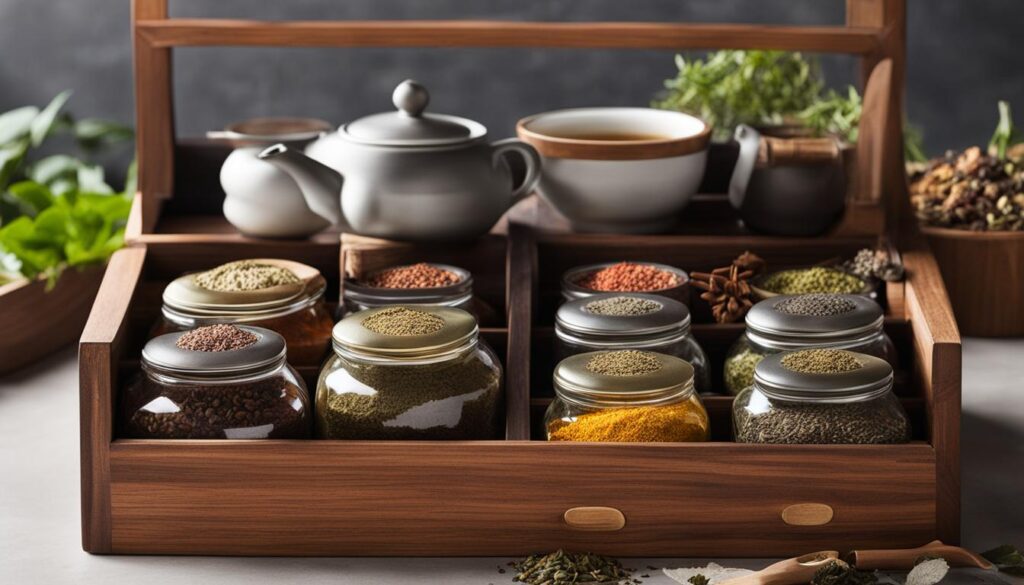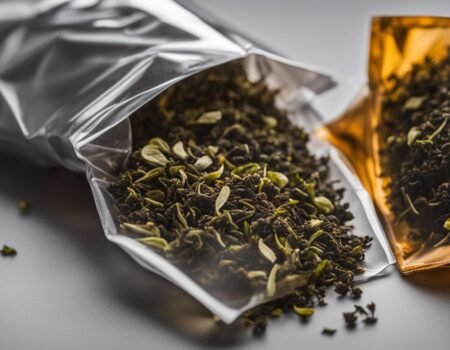
Comprehensive Guide: How to Store Tea Effectively
Welcome, tea enthusiasts! Are you tired of sipping lackluster tea with diminished flavor? Look no further! In this Comprehensive Tea Storing Manual, we will take you on a journey to unlock the secrets of keeping your tea fresh and delicious. Say goodbye to stale and lackluster brews as we guide you through the essential steps of tea storage.
Tea, with its delicate flavors and aromatic profiles, deserves to be stored with utmost care. Our Tea Freshness Keeping Guide will equip you with the knowledge to avoid the five key enemies of tea storage: light, heat, moisture, odor, and air. Together, we will explore the important factors to consider when choosing the right tea container and the best practices to maintain tea quality.
Key Takeaways:
- Proper tea storage is crucial for maintaining freshness, quality, and flavor.
- Avoid exposing tea to light, heat, moisture, odor, and air.
- Choose opaque containers to protect tea from light.
- Store tea in a dry environment to prevent moisture-related issues.
- Keep tea away from strong-smelling items to avoid odor absorption.
Choosing the Right Tea Storage Container
When it comes to storing tea, choosing the right container plays a crucial role in preserving its freshness and flavor. Here are some essential tea storage tips and recommendations to ensure your tea stays at its best:
Airtight Tins and Canisters
Airtight tins or canisters with a secure seal are excellent options for preserving tea’s flavor and protecting it from air and moisture. These containers provide a barrier against external elements and help maintain the quality of your tea. Look for tins or canisters specifically designed for tea storage, with seals that create an airtight environment.
Glass Jars with Airtight Seals
Glass jars can also be used for tea storage, but to prevent light exposure, it’s essential to keep them in dark areas or wrap them with opaque material. Glass jars with airtight seals can effectively keep air and moisture out, preserving the freshness of your tea.
Ceramic or Clay Containers
If you want to add an aesthetic touch to your tea storage area, consider using ceramic or clay containers. These materials offer good insulation and protection against light and moisture. Ceramic and clay containers can also help maintain a steady temperature, contributing to optimal tea storage conditions.
Vacuum-Sealed Bags
For long-term storage or if you have a large quantity of tea, vacuum-sealed bags are a great option. These bags remove excess air, creating a vacuum seal that helps preserve the tea’s freshness. Vacuum-sealed bags are particularly useful for teas that you won’t be using regularly.
When storing tea, it’s important to ensure proper sealing to prevent air and moisture from entering. Avoid using plastic containers as they can absorb odors and affect the taste of your tea. Transferring tea from its original packaging to airtight containers will maintain its quality and ensure a delightful cup of tea every time you brew.

Conclusion
Properly storing your tea is the key to preserving its quality and flavor. By following our step-by-step tea storage guide, you’ll ensure that each cup of tea you brew is a delightful and satisfying experience.
Remember, the five enemies of tea storage are light, heat, moisture, odor, and air. To protect your tea, choose a container that is opaque and airtight to shield it from light and air exposure. Store your tea in a cool and dry place, away from strong odors that can easily be absorbed. By considering these tea packaging do’s and don’ts, you’ll keep your tea fresh for longer.
Whether you prefer green, black, oolong, white, or herbal tea, the principles of proper tea storage remain the same. And don’t forget to buy tea in small quantities and rotate your stock to enjoy the freshest flavor possible. If you’re looking for long-term storage, vacuum-sealed bags or freezing can be your go-to options.
With our tea quality preservation handbook, you now have all the tools you need to become a tea storage expert. So go ahead, brew a cup of your favorite tea, and savor the rich flavors knowing that you’ve mastered the art of tea storage. Cheers to a fragrant and delicious tea experience!
FAQ
Why is proper tea storage important?
Properly storing tea is crucial for maintaining its shelf life, quality, and flavor.
What are the key factors to avoid when storing tea?
The key factors to avoid when storing tea are light, heat, moisture, odor, and air.
How does light affect tea?
Light and UV rays can degrade tea quickly, so it’s important to choose containers that are opaque and keep tea away from sunlight.
How does heat affect tea?
Heat degrades tea, so storing it away from heat sources is essential.
How does moisture affect tea?
Moisture can cause tea to become damp and moldy, so it’s important to store it in a dry environment.
How does odor affect tea?
Tea absorbs odors easily, so it’s best to store it away from strong-smelling items.
How does air affect tea?
Air exposure increases the chances of tea absorbing moisture and odors, so using airtight containers is recommended.
What are some recommended tea storage containers?
Airtight tins, canisters with airtight seals, glass jars with airtight seals (kept in dark areas or wrapped with opaque material), and ceramic or clay containers are good options.
What is the importance of proper sealing?
Proper sealing is important to prevent air and moisture from entering the tea storage container.
Are plastic containers suitable for tea storage?
It’s best to avoid using plastic containers as they can absorb odors and affect the tea’s taste.
Should I transfer tea from its original packaging to airtight containers?
Yes, it’s recommended to transfer tea from its original packaging to airtight containers for optimal storage conditions.
How can I extend the shelf life of tea?
Buying tea in smaller quantities, rotating your tea stock, and considering freezing for long-term storage can help preserve its quality.






